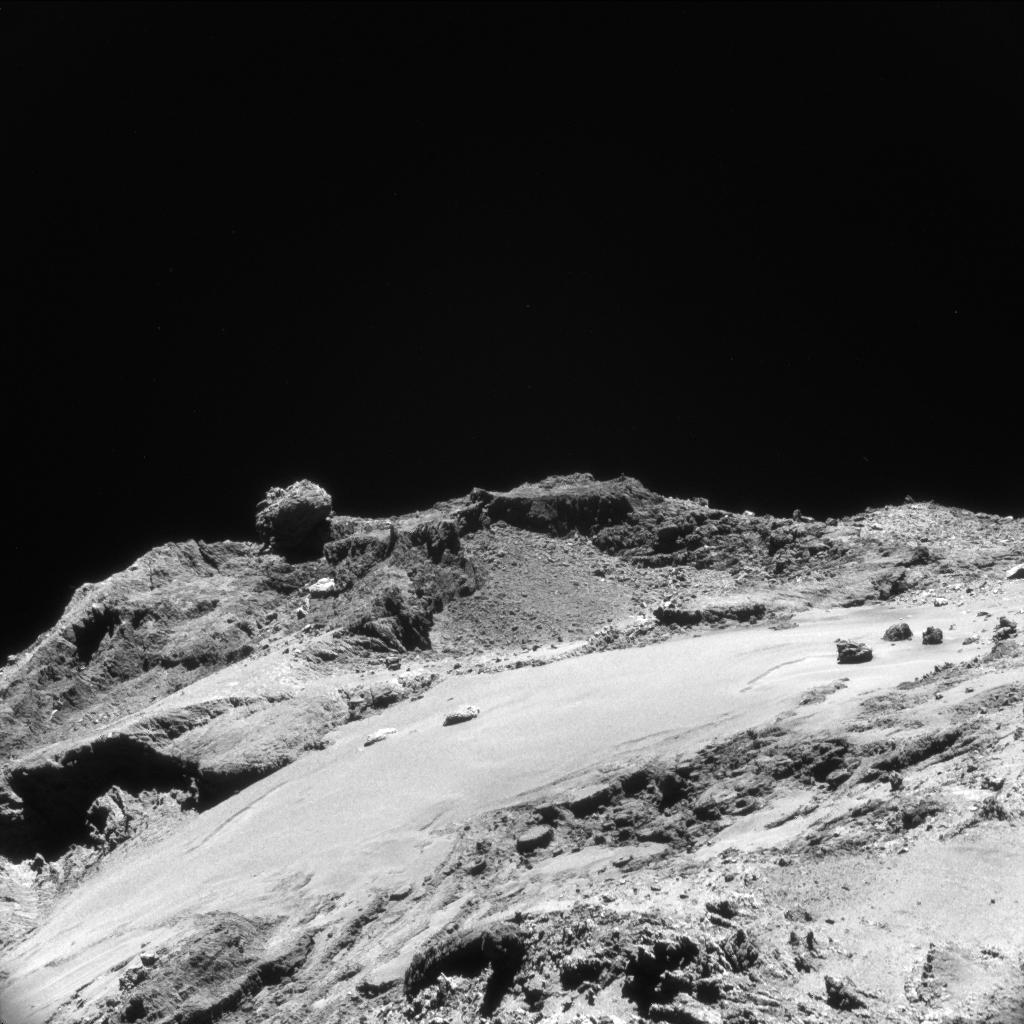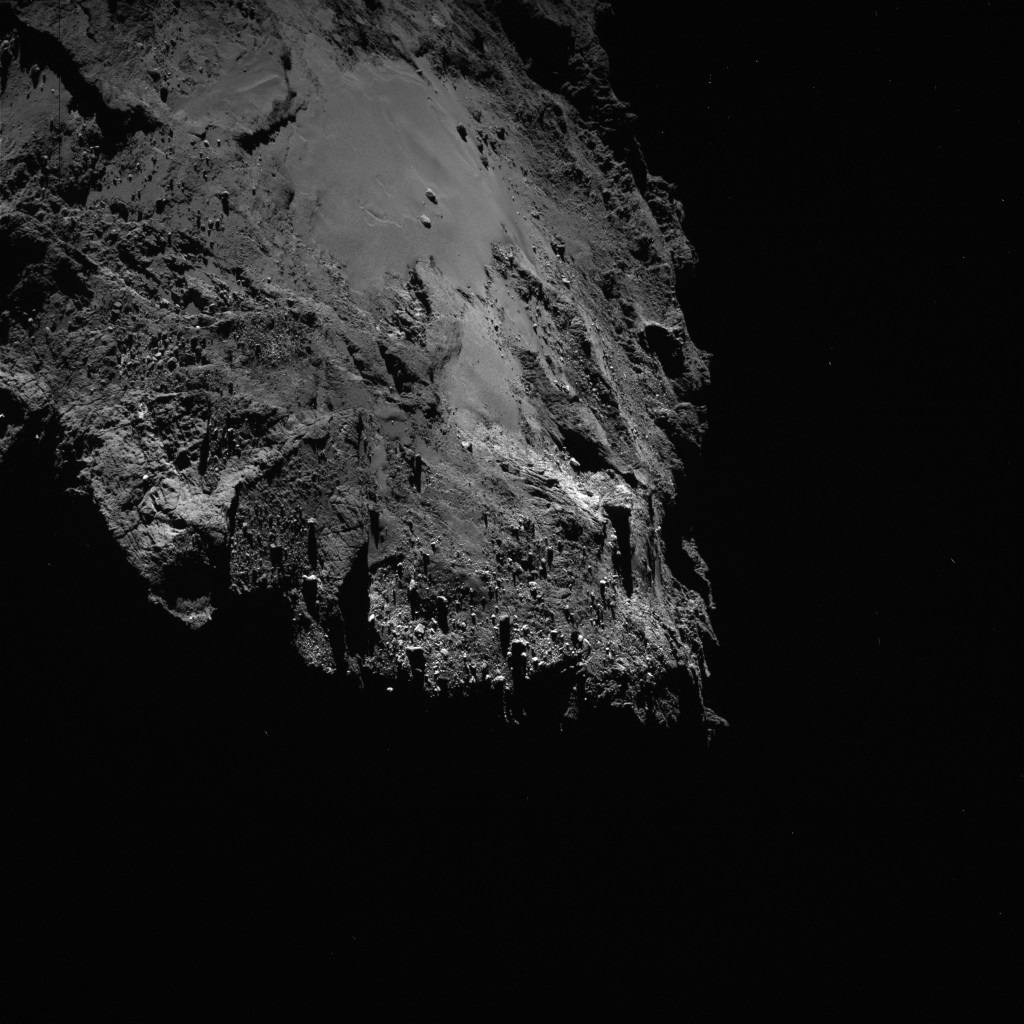This week’s CometWatch entry from Rosetta’s NAVCAM was taken on 19 March from a distance of just 12 km.

Lightly enhanced Rosetta NAVCAM image of Comet 67P/Churyumov-Gerasimenko taken from a distance of 12 km. The image scale is 1 m/pixel and the image measures 1.1 km across. Credit: ESA/Rosetta/NAVCAM – CC BY-SA IGO 3.0.
It captures a beautiful oblique view across the plains of Imhotep, taking in the cluster of boulders to the right of the image that includes 25m high Cheops.
The rugged, fractured terrain and debris slopes in the background, where Imhotep meets Khepry, makes for a spectacular horizon.
This region can also be seen, albeit from a much different orientation but which shows the wider context of the region, in the OSIRIS wide-angle camera image below captured on 16 March.

OSIRIS wide-angle camera image taken on 16 March 2016, when Rosetta was 14.4 km from Comet 67P/Churyumov–Gerasimenko. The scale is 1.36 m/pixel. Credits: ESA/Rosetta/MPS for OSIRIS Team MPS/UPD/LAM/IAA/SSO/INTA/UPM/DASP/IDA
Following the brief encounter at these close distances, Rosetta is now heading out on an anti-sunward excursion to around 1000 km to investigate the comet’s wider coma, tail and plasma environment. Today, 24 March, Rosetta is already over 200 km away from the comet. The current plan is for Rosetta to make a 30 km zero phase flyby around 9 April, before entering back into closer bound orbits by 21 April.
Follow the spacecraft’s trajectory in the coming weeks with the Rosetta NOW tool.
The original 1024 x 1024 pixel NAVCAM image is provided below:










Discussion: 8 comments
Hi Emily
The OSIRIS photo is mirror-flipped. It says “raw” on the details section at the OSIRIS website. It’s still a very nice photo but some may headscratch like I did when I first saw it.
Around halfway along the bottom edge of the OSIRIS photo is where the controversial jet was emanating in the Cometwatch 1st March post. Lighting of the rim has caught it differently so it’s a slightly different profile and difficult to ascertain the exact emerging point. However, its source would be almost certainly tucked under the rim from this view.
The following is based on my best interpretation of the pictures but is no substitute for rotating the shape model under the sun line. It’s difficult to judge the sun line and exact illumination of specific areas at specific times. But that said….
The equator runs at about 45° from top-left to middle-right and the direction of rotation is anti-clockwise in this view. Therefore, it seems the jet’s source was potentially in a favourable position to have been in shadow for a long time before the Cometwatch photo was taken. That’s owing to the fact that the sun line was almost directly over the base of the comet and couldn’t illuminate the other side of the rim where the jet source was (or at least only sporadically and obliquely if Ramcomet’s V shape allowed it through briefly. That would have been the case for about three hours if the sun had been directly overhead. So the average surface line of the terrain the other side of the rim line experienced sunset about 3 hours before the 1st March Cometwatch photo was taken. This would imply a possibly deeper thermal skin depth in certain places at least.
Some may be interested to know the reason why the horizon is, as you say, rugged and fractured. Or at least, the reason according to Marco’s and my opinion, that is. It’s in the latest stretch blog offering.
(Apologies for any typos- typed straight into comments box on phone).
Thanks very interesting 🙂
There seems to be an interesting feature near the bottom of the image, a bit to the left. It’s rather linear and looks artificial – it can’t be a part of Philae, can it?
https://i1176.photobucket.com/albums/x330/zoo3hans/zoo3hans031/snapshot1355_zpsiabibyuw.jpg
Looks very flat
Looks like an interesting formation in Khepry.
I noticed that linear feature too!…close up it looks like a Guitar…possibly Elvis’s.!
I also see a white Tank hiding behind rocks under the large boulder on the horizon.
Beautiful indeed. I still can’t believe we are able to gaze across this mysterious world, in such high-resolution, images, from this extraordinary distance. As if we are just gliding over its surface with our binoculars out. OSIRIS makes space voyagers of us all.
Hats off to the team processing & sharing these images.
Nicely said Siobham!
And I am also profoundly grateful for this blog, and for Rosetta Team turning sci-fi into sci-fact, by the sheer, incredible perseverance of all of the hardworking team for over a decade.
Mankind can be pretty cool! 🙂